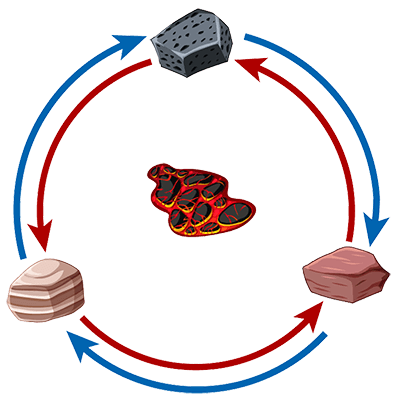This is a lesson summary. The full lesson can be viewed by purchasing an online course subscription.
Learning Objective
In this lesson we will learn about the three main types of rocks and how they are linked via the rock cycle.
Learning Outcomes
By the end of this lesson you will be able to:
- Define what rocks and minerals are.
- Compare the three main types of rocks, with examples.
- Describe the rock cycle and the processes that are involved.
- Give examples of how rocks have been used by humans over time.
- Discuss how rocks contain information about past geological and biological events.

(Image: blueringmedia, Adobe Stock)
Lesson Summary
- A rock is a naturally occurring solid object composed of one or more minerals.
- Rocks are grouped into three main categories based on how they are formed:
- Igneous rocks are formed when magma or lava cools and solidifies.
- They are generally hard and strong as they are composed of interlocking crystals.
- Sedimentary rocks are formed by the compaction and cementation of sediments or the precipitation of dissolved minerals.
- They are generally soft and easily broken apart as they are composed of non-interlocking grains.
- Metamorphic rocks are formed when existing rocks undergo a transformation under high pressure and/or high temperature.
- They are generally very hard and strong as they are composed of compressed, interlocking crystals.
- Rocks can also be classified based on their physical structure or their chemical composition.
- A mineral is a naturally occurring solid substance with a defined chemical composition and crystalline structure.
- Minerals may can be elements or compounds. Minerals that are compounds are named differently to the chemical compounds they are composed of.
- The rock cycle is a series of geological processes that represent transitions between igneous, sedimentary and metamorphic rocks.
- The rock cycle includes processes that occur on Earth’s surface and processes that occur beneath Earth’s surface.
- Most of the processes that are part of the rock cycle take place over very long periods of time.
- The key processes involved in the rock cycle are:
- Melting – the formation of magma.
- Crystallisation – the formation of igneous rock.
- Weathering and erosion – the formation of sediments.
- Deposition and lithification – the formation of sedimentary rock.
- Metamorphism – the formation of metamorphic rock.
- Rocks have been used by humans for thousands of years, for their physical properties and for the minerals that they contain.
- The study of rock strata reveals information about past geological events, such as volcanoes, earthquakes and other tectonic activity.
- The study of fossils found in rocks reveals information the evolution of life.
- The geological time scale is a timeline that divides Earth history into intervals that correspond with major geological and biological events.

(Image: Dieter Mueller, Wikimedia Commons)
(Header image: elena_suvorova, Adobe Stock)
